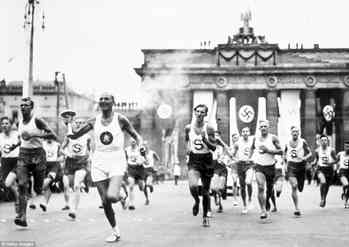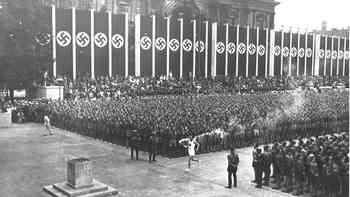The Olympic Flame Scam: a Wonderful Idea From Dr. Goebbels!

Overflowing with national pride, the Greek media, seconded by the country’s grandiloquent authorities, don’t miss the opportunity to present this veritable re-enactment of a Nazi ceremony, namely the so-called “Olympic flame lighting ceremony” in Olympia… as proof of the greatness and historical continuity of the Greek nation. And with it, to present its accessories too, such as “the first Olympic torch” which, as we read, was handed over to the mayor of Marathon, “in a magnificent ceremony that included a symbolic torch run from the Marathon Historic Start Line to the Marathon Run Museum”.
Significant detail, which is of course systematically passed over in silence, as it is considered… “a national secret”: this “first torch”, inspired by Goebbels and manufactured by Krupp, was lit in Olympia with a choreography, which remains the same to this day, by Hitler’s official director, the infamous Leni Riefenstahl. It has to be said that this “first torch” fell on hard times in 1936, when Czech citizens stoned the German-speaking torchbearers as they passed through their country, because it was obvious that the route they were following marked the contours of the great Third Reich, which was to become a nightmarish reality four years later. Apparently, these Czech citizens of 1936 knew in advance what the Greek media and the authorities of our poor country still persist in ignoring… in 2024. So here’s why we’ve been looking forward for decades to the moment when this flame is irrevocably extinguished: simply because “the Olympic flame” is “a wonderful idea of Dr. Goebbels”, as the full-page headline of the Greek daily Estia aptly stated in August 1936…
So, what ancient ancestors, virgin priestesses, sacred flames and other tall tales are we talking about? All this nonsense that the entire Greek state and its political staff, including 9 out of 10 of its official intellectuals, have taught us to believe comes straight from the depths of the ages, is only celebrating its… 88th birthday! At the end of July 1936, shortly before the opening of the Olympic Games of triumphant Nazism in Berlin, Greek newspapers carried articles with the usual patriotic and epico-lyrical accents, celebrating Leni Riefenstahl and her “Olympic flame lighting ceremony”, of which here are a few edifying extracts:

“When Olympia awoke, when the sun rose behind the conical, green Mount Cronion and silvered the waters of the Kladeos and the Alpheus, the people who suffered under the scorching sun of the historic July 20, 1936, each took their place: some under the pines of the Cronion, others around the gates of the Place Coubertin. And they waited all night until the moment when, from the Cronion hill, the signal was given for the ceremony to begin. Further on, in the morning, a wonderful woman – Leni Riefenstahl – had brought her film crew and, at the starting line of the ancient stadium, staged the lighting of the Olympic flame herself. Then, at the Temple of Hera, she demonstrated her genius as a director. She took Pratsika and her schoolgirls, immediately she made an actor out of her cameraman- for Condylis, the first runner, had no intention of wearing the tight underpants worn by the ancients; she stripped him down, made him a runner, lit dried herbs from the sacred Altis on the makeshift altar formed by the drums of the columns, adjusted the engines and shot the film, giving advice, orders and instructions. Ten times she shot the same thing, the start with the torch of the first runner. The German was literally roasted, sweat oozing like a river. Riefenstahl threw him a towel to dry himself off and started shooting again”.
(…) As this takes place on Place Coubertin, at the starting line of the ancient stadium, a beautiful ritual unfolds. Pratsika’s light-bearing virgins take in the Olympic light from the sun. They are all alone. No one is allowed to witness the lighting. And in fact, at this ceremony, which Leni Riefenstahl had filmed in the morning during rehearsals, no one was to be present – only Phoebus and the Greek virgins, the fire-givers, were supposed to witness the divine ceremony.
(…) It’s the most moving moment. Everyone looks on in silent admiration and respect. The Olympic light will be transmitted. Young Condylis, from Olympia, crosses the girls of light and lights the torch from the altar fire. This is the moment everyone has been waiting for. It’s impossible that everyone’s bodies haven’t stood still, that their breath hasn’t stopped for a moment, that their mouths haven’t gone numb. The sun, a blazing silver sun, bathed the whole idyllic green land of Olympia. Young Condylis, half-naked, sunburned, has just lit the first torch, and is running… running, holding it aloft. The crowd erupts in applause and bravos.
In an instant, he rounds the Cronion ring road and is off, running with the sacred flame of Olympia to transmit the Olympic light – the eternal Greek civilization of feat and spirit”(1).
(VRADYNI newspaper, Tuesday, July 21, 1936)
As we would say today, a Hollywood spectacle staged by the Nazi party’s official ceremonial director, Leni Riefenstahl, based on an idea by Dr. Goebbels, heartily approved by Chancellor Hitler!

Let’s suppose you are right, might -finally- exclaim the Greek officials of all kinds who keep their mouths shut and feign ignorance. And of course, they’ll counter-attack: but that doesn’t necessarily mean that all Olympism is rotten, that Baron de Coubertin’s Olympic idea is no longer valid, and that it shouldn’t inspire us.
So let’s talk about the “father” of Olympism, the inspirer and founder of the modern Olympic Games, de Coubertin, whose name adorns streets and squares all over the world and especially in our country, Greece. We’ll say it straight out: Our good Baron was a rare racist, militaristic, reactionary, colonialist, misogynistic and warmongering individual of the extreme right (with obvious Nazi sympathies) before whom a Donald Trump or his compatriot Marine Le Pen pale in comparison! And here’s a small anthology of his “credos” formulated by the Baron himself, who throughout his life never ceased to declare himself – and to be – a “fanatical colonialist” and a supporter of all inequalities (of class, race and gender):

Drawing by Sonia Mitralia.
+ “the races are not of equal value and all others must pledge allegiance to the white race, which is inherently superior”
+ “There are two distinct races: the honest ones, with their strong muscles and confident gait, and the sickly ones, with their humble, desperate looks and defeated gaze. So, in colleges as in the world: the weak are sidelined; this education can only be appreciated by the strong.”
+ “Don’t let anyone talk to us about games in which women, teenagers – in short, the weak – can take part.”
+ “The only true Olympic hero is the male individual. Female Olympiads are unthinkable. They would be uninteresting, unattractive and untrue. At the Olympic Games, their role should above all consist, as in the ancient knights’ tournaments, in crowning the winners.”
+ “The superior race has every right to deny the inferior race certain privileges of civilized life”.
+ “The young athlete certainly feels better prepared than his ancestors to go to war. And when we are prepared for something, we do it more willingly.”
+ “I would like to thank the German government and people for the efforts they have made in honor of the eleventh Olympiad” (…)”. How could I renounce the celebration of the Eleventh Olympiad, since (…) this apotheosis of the Nazi regime was the emotional shock that allowed the Olympic Games to develop?”
So it was only natural that, shortly afterwards, Chancellor Hitler should nominate de Coubertin for… the Nobel Peace Prize!
Epilogue: All this is now common knowledge, and we have no illusions that historical or other arguments will “convince” the powers that be to put an end to what is the greatest swindle of the last two centuries. If anything can put an end to this improbable – yet true – “Olympic” mix of Nazi and commercial circus of corruption and alienation, it’s the movement of citizens in flesh and blood alone. After all, nothing is built on lies and fraud…
Note
1. See extracts from the film shot by Riefenstall on this occasion in Olympia in 1936:

